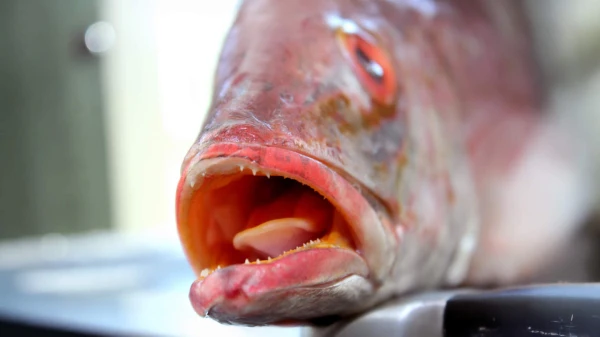
How they sense taste and what allows them to hunt in murky water.
The tongue is a movable muscular organ in the oral cavity that participates in food processing, swallowing, and, importantly for humans, in the formation of speech sounds. By these strict criteria, fish do not have a tongue. But in place of the "absent" organ, they have another.
What do fish have instead of a tongue
The hyoid bone in fish is an immobile bony structure that protects vessels, participates in swallowing, and, in some species, serves as a weapon.
If you look into the mouth of, for example, a pike or a perch, you can see something that at first glance resembles a tongue. But this is a deceptive impression. At the bottom of the mouth is not a muscular organ, but a special bony plate.
How does the hyoid bone fundamentally differ from a regular tongue?
The hyoid bone is part of the fish's skeleton, a solid and immobile structure. It lacks complex musculature, meaning it cannot move as freely and flexibly as our tongue. Moreover, it has no taste receptors.
Why do fish need a hyoid bone?
Scientists have several answers. The first and most important function is protective. The fact is that directly beneath the hyoid bone, in a very vulnerable spot, runs a large blood vessel—the abdominal aorta, which carries blood from the heart. The hard bony plate serves as a reliable shield, protecting this "main artery" from damage by the live and wriggling prey that the fish engulfs.
Additionally, the hyoid bone actively participates in feeding. Although fish do not chew their food, they need to direct it into the throat. This is where the hyoid bone helps. Working together with the movements of the jaws and gill covers, it acts like a piston or paddle, pushing food further down the esophagus. This is especially noticeable in predatory fish. Observing how a pike or zander swallows its prey, one can see how harmoniously their oral apparatus works, with the hyoid bone being an important part of it. In many cyprinid fish (for example, bream or roach), it represents a hard keratinous plate that helps grind food against the palate.
But that's not all! In some fish, the hyoid bone has evolved into a formidable weapon. A classic example is the sheephead fish, which inhabits the shores of South and North America. It has powerful teeth located on its hyoid bone, which help crush the shells of crabs and mollusks. One genus of deep-sea fish is even named Glossanodon, which literally means "tongue-tooth."
How do fish taste without a tongue?
Since fish are constantly surrounded by water, they do not need to concentrate taste receptors exclusively in their mouths. Water is an ideal conductor for chemical signals, and fish make the most of this. Their taste buds can be located anywhere: on their lips, fins, whiskers, and throughout their body surface.
A prime example is the common catfish. It is a true "taster." Its long, sensitive whiskers are covered with thousands of taste receptors. But that's not all. The channel catfish, for instance, has a total of 680,000 taste buds across its entire body! In comparison, humans have only about 5,000.
This means that the catfish swims through the river and literally "tastes" the water around it. It can determine the taste of prey or danger simply by swimming by, touching the bottom with its fins, or directing a stream of water with chemical signals onto its whiskers. This ability allows it to hunt effectively in murky water, where visibility is limited. Catfish do not so much search for prey with their eyes as they "detect" it by taste and smell.
Similarly, burbot and carp operate. They also actively use a distributed taste system to search for food in the bottom sediments. Thus, fish are not just devoid of a tongue—they have transformed almost their entire surface into an organ of taste.













